When it comes to bikes, their frame size matters. If you don’t know how to measure a bike size, then need not worry! You have landed at the right pace.
Just as you wouldn’t buy a pair of shoes without first trying them on, you shouldn’t buy a bike without knowing if it’s the right fit.
The good news is that measuring a bike for size is easy to do and only takes a few minutes.
So, what are we waiting for now? Let’s start with measuring bike parts straight away to get you closer to your ideal fit.
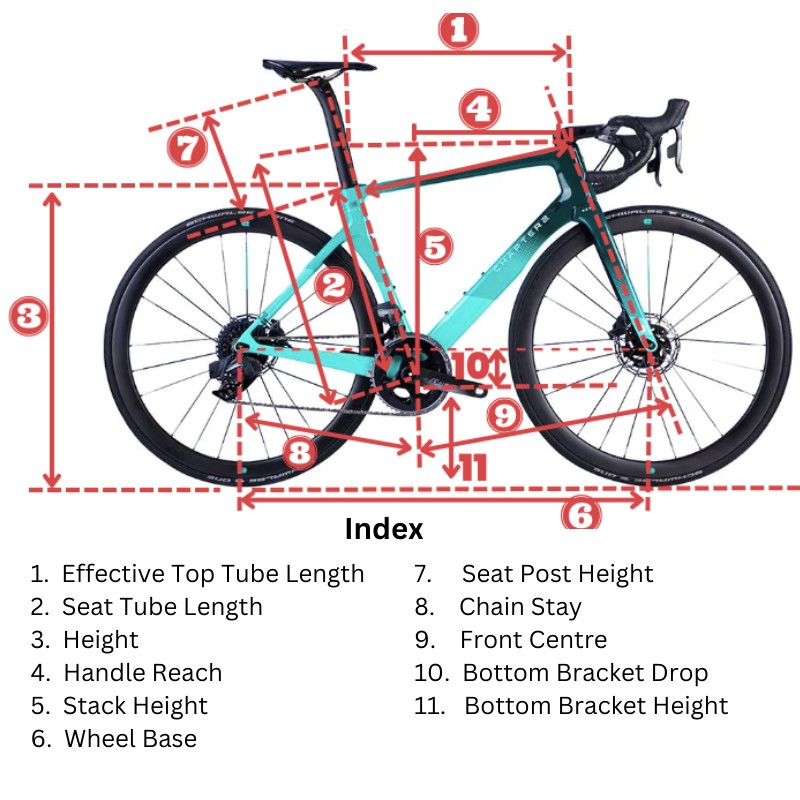
What is a Bike Size
Essentially, bike size refers to the size of the bike frame, which is a standard measurement for knowing the right fit bicycle according to one’s body type.
Choosing the right fit can be a daunting task when there are so many different sizes out there. Some people might be lucky enough that they know their height or weight to find the best size, but for most, it’s a bit more complicated.
This is why it’s of utmost importance to look for charts and analyze all angles before going to a bicycle shop. Trust me; it makes all the difference in the world.
Uncovering the Importance of Bike Size
Riding a bike of the correct size compliments your body and helps you set the pace of your ride. You travel faster, enjoy more, and feel little to no discomfort.
Not just this, but the right bike size also impacts the balance and trajectory of your handles. You’ll end up driving more conveniently, thus avoiding accidents.
A bike of the wrong size can lead you to sit in uncomfortable positions for long hours at a stretch. Over time, your body will get used to this bike fit, all thanks to muscle memory and cognitive brain control.
Make sure to find the right size bike before you adapt to the wrong bicycle for life.
Bike Size Measuring Unit
The majority of bikes you see in bike shops or stores today are measured in standard metric units by the cycling industry—whether road bikes, mountain bikes, hybrid bikes, or any other. But still, some manufacturers like to mix meters with inches or have a strict inches-only policy.
For ease and correction, we’d want you to take your measurements in metric units, and if needed, you can convert them into inches later.
All websites and bike-making brands attach a frame geometry table for frame sizes of all bike models they have in stock. Make sure to use these charts as a reference. This trespasses you from a million sizing errors you can make while calculating bike size.
Guaranteed Ways to Measure A Bike Frame Size Effectively
When you measure a bike’s size, you’re actually measuring the frame components that make up the bike. So, it’s highly recommended to take note of the following fundamental values of a bike frame.
1. Top Tube Length
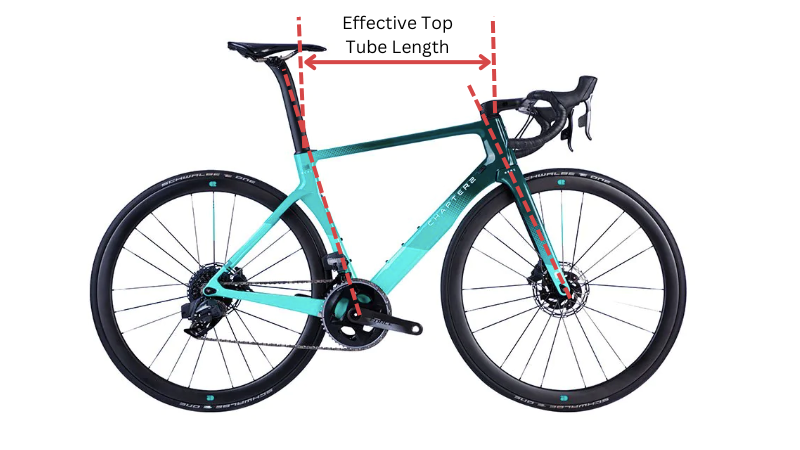
Start by measuring the top tube length. Earlier, most bikes had horizontal top tubes, whereas bikes today have sloped top tubes, which means they are at an angle.
Most geometry tables contain the actual top tube length already. But to go precise with the accuracy, it’s necessary to measure the HORIZONTAL tube angle, regardless of the angle they make. This horizontal top tube length is called effective top tube length. Many geo charts refer to it as a virtual top tube.
This means that we have to clearly measure the horizontal distance between the head tube’s centreline and the seat post’s centreline.
To avoid errors, use your spirit level or the Clinometer app, which is known for an accurate measure, at all times. The Clinometer app is available for both Android and iPhone users.
You should know that many companies size road bikes based on top tube length, but mountain bikes do not follow this sizing pattern.
2. Seat Tube Length
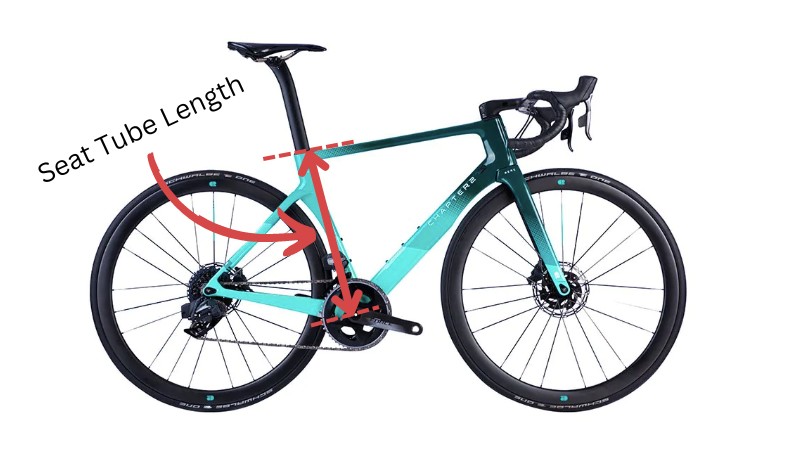
For the bikes in the market, the factor that marks their categorization along with the top tube length is the seat tube length.
In many conventional bikes and some hybrids that we see in the market today, the frame size is nothing but the seat tube length itself, so make sure to look at it. It’s expressed in centimeters, whereas in mountain bikes, the frame size or seat tube length is measured in inches.
The bike’s frame size is highlighted with a decal sticker on the bike’s seat tube surface. If you are still looking for the numbering labeled, you can measure it to avoid all confusion.
How to measure Seat Tube Length
It’s easy to measure the value, and you can hardly go wrong if you do it right.
Firstly, check out if there is any size labeled near your seat tube’s bottom, i.e., almost 3 inches above your chain sprocket. Although not all bikes have the size mentioned if your bike has one, then this can ease your work a lot.
Remember, size can be mentioned either in inches or centimeters. However, the most general size you’ll notice on almost all bikes is somewhere between 48 cm–62 cm.
The second step is for those riders who do not have their frame size mentioned on their bike. Start by placing one end of your tape in the center of the gear crank. And measure it to the top tube’s very endpoint. With this, you’ll get your bike seat tube length.
Easy right? Remember that most regular bikes in the market have 21-23 inches of seat tube length.
Now, if you have a road bike and are willing to convert inches into centimeters, then it’s very easy. Simply multiply your inches value by 2.54. And you’ll get your exact number. However, in case you have a mountain bike keep measurements in inches only.
3. Height
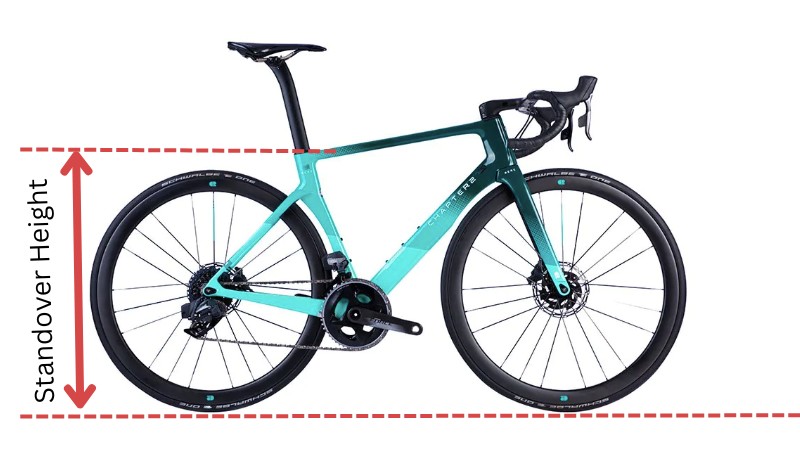
Height is another prime measurement when bike manufacturers want to differentiate between indefinite frame sizes.
So, you have to start by calculating your height if you haven’t already. This number will come in handy whether you purchase a bike online or from a store.
When you know your height, you can have a rough idea about the right bike fit. Where are the pedals and handles placed? It will all depend on the height or the vertical distance from the ground.
4. Handle Reach
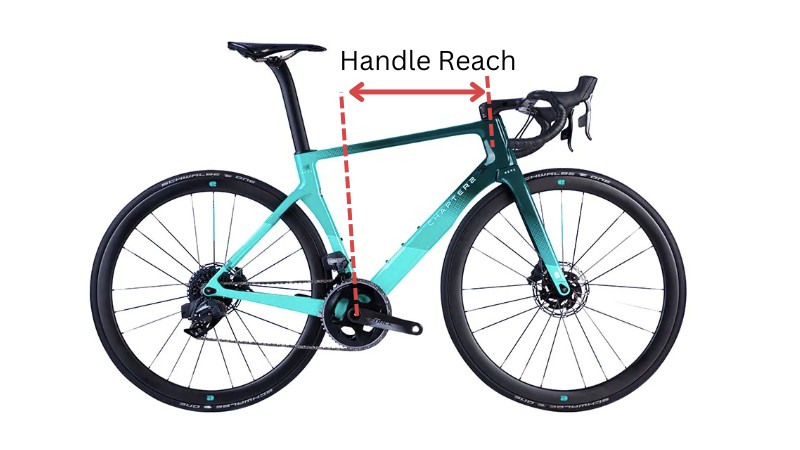
The hand reach can be quickly sidelined, but its correct measurement is exceptionally underrated when ensuring ‘tension-free’ rides. And by this, we are not just talking about the mental discomfort but the pain in our shoulders.
You are not gonna sit upright while riding a bike; obviously, you will bend a little forward and extend your arms to grab the handlebar, which is located at a horizontal distance. For it to happen organically, you have to measure your reach.
As you can guess, reach is the horizontal distance from the pedals’ center part to the handlebars. This is hugely important as it approximates how far a rider has to bend or reach to get off the bike’s handle. It can also show its effect on your saddle style.
5. Stack Height
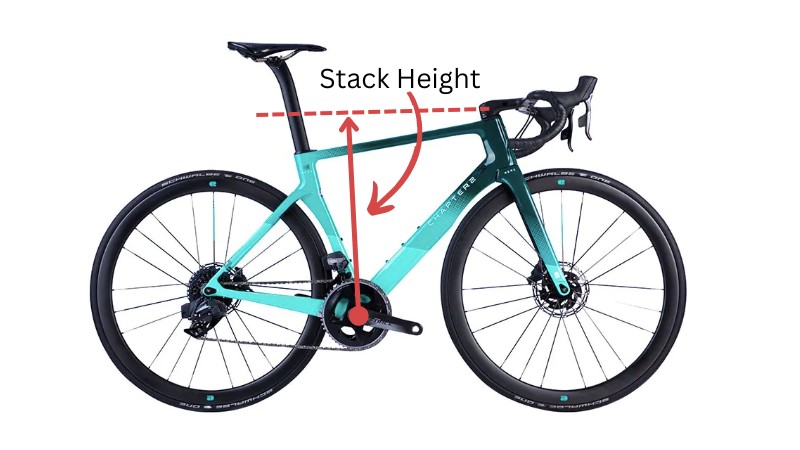
It gives the measure of the altitude of the handlebars above the frame of the bike. The lower the stack height, the more you bend to reach the handlebars. Similarly, high stack height makes use of the spacers to elevate handlebars a little, making handlebars more accessible to the person riding the bike.
You can maintain an erect back position in this setup without hurting your neck. This measurement can go unnoticed by some but make sure to work a little to get it right because it will help you find the perfect match for your bike.
6. Wheelbase
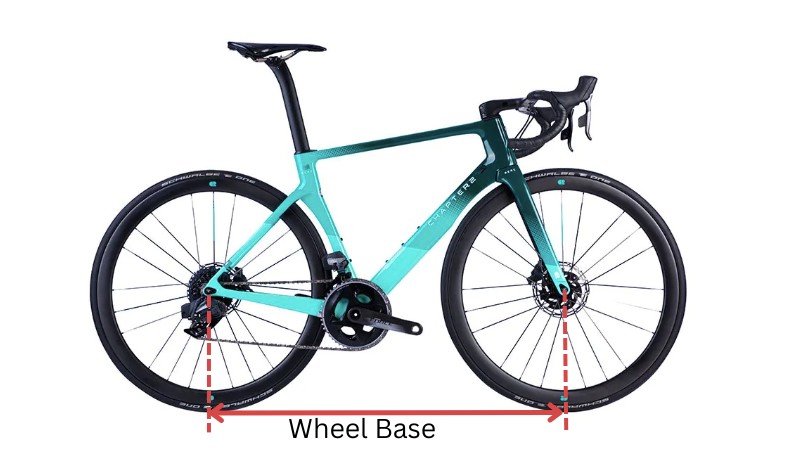
The wheelbase measures the interspace between your bike’s front or rear axles. This stretch between the two varies from frame to frame and will affect the smoothness of your bike ride.
It’s relatively simple to note but just like all other measurements, repeat it a few times to kill all possibilities of going wrong. While measuring, we advise you to pay attention to whether the fork is set straight ahead to get an even precise number.
Additional Tip: Calculate the Wheelbase on either side and note their mean value. It will counterbalance if the fork is unfortunately not straight.
On the other hand, kids and junior bikes come with different measurement criteria. It’s the diameter of the wheel that influences the bike sizes and, eventually, the right fit.
The wheel size is the standard reference used in commonly found kids’ bike sizes such as 12″, 16″, 20″, 24″, and 26″. For an even better understanding, read our kid’s bike chart as you move along with the article.
7. Seat Height
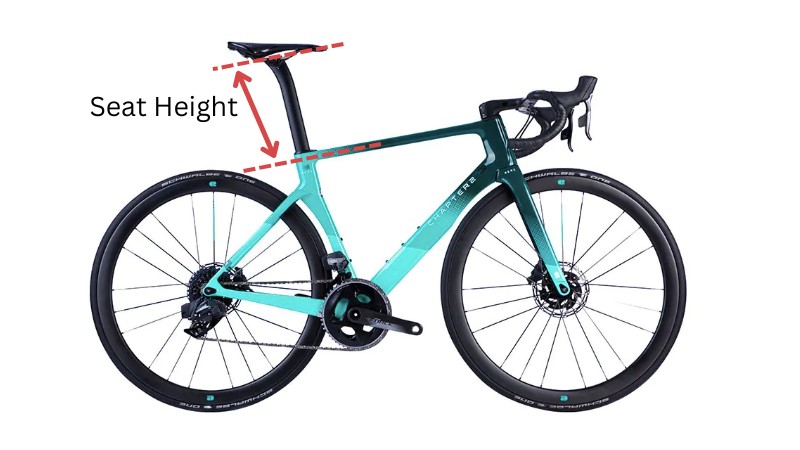
Seat Height can be adjusted very quickly, but this will only matter if you can decide your optimum seat height, for it will influence many things. Bikes have an upper and lower limit position of the seat height, giving the biker multiple options to ensure the correct size.
Steps to measure Seat Height?
To finally test the most accurate bike fit, select a random seat height and then sit on it, placing your feet on the pedal with your socks or shoes on.
You can take a bit of support from the wall or ask your friend to help you in the process.
When your feet move the pedal to its bottommost position in a circle, notice the angle your leg makes. You have almost found your seat height if the angle is around 15° to 20°.
If you experience too much bend or discomfort or get the vague feeling to either overextend your leg and adjust yourself, the seat height needs to be corrected. It will hurt your feet in the long run.
8. Chainstay Length
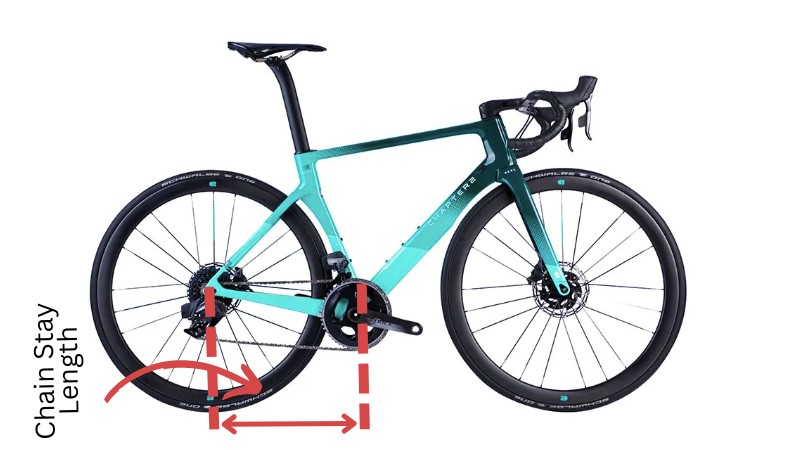
Your wheelbase is made of two elements, one of which is the chainstay length which plays a massive role in defining the handling characteristics of your bike frame.
A structure with shorter stays instead of extended stays will immediately increase vitality and exuberance. So in exact terms, the chainstay length is a straight line distance that can be easily measured using a ruler.
Just place the ruler from the center of the bottom bracket drop to the center of the rear axle.
9. Front Center
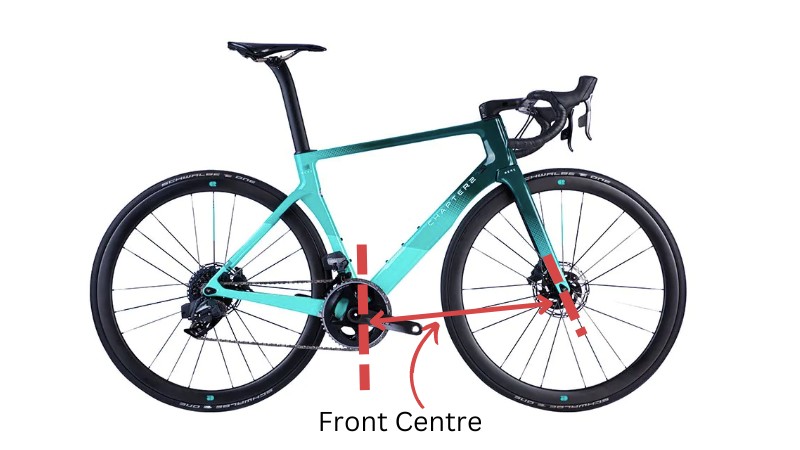
The front center is the other element of the Wheelbase. It’s mostly identical to the chainstay length but has a contrasting estimation method—it is counted from the axle until you reach the front dropout.
It alters both handling and the case of toe overlap with the front wheel.
10. Bottom Bracket Drop
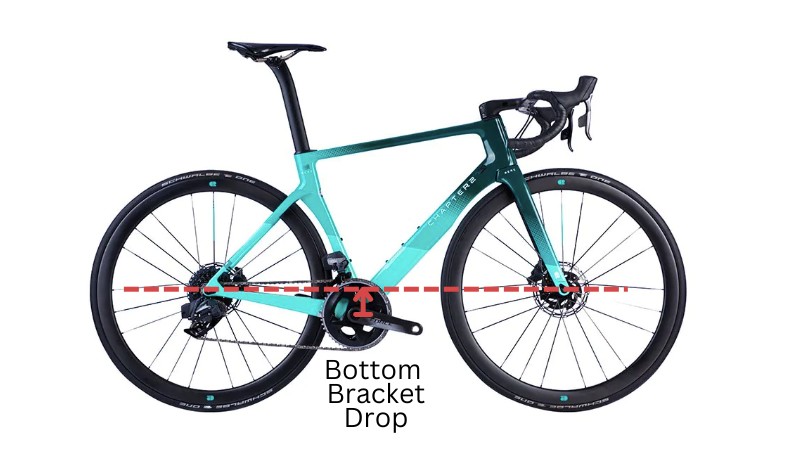
You should know that the back bottom drop is the distance you get from the height of the wheel’s access to the centerline of the crank axle.
Start by obtaining the height of the rear axle, followed by the size of the bottom bracket. When you get the values, subtract them, and you will have your exact measurement. This measurement, too, is given importance in geo charts.
11. Bottom Bracket Height
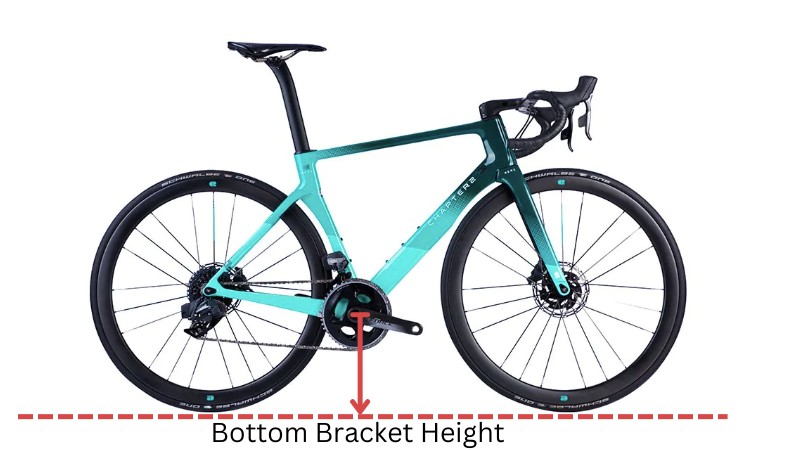
So, the bottom bracket height is the distance you obtain from the ground to the bottom bracket shell’s length. The reading can be taken very quickly, provided the bike is upright.
The measurement is known to be affected by the bike’s tires, so we advise you to check on inflation. This doesn’t affect the bottom bracket drop, though.
Finally, we have all the major and minor measurements you need to measure the correct frame size. Write the values in a table to find ease at the bike store.
12. Leg Inseam
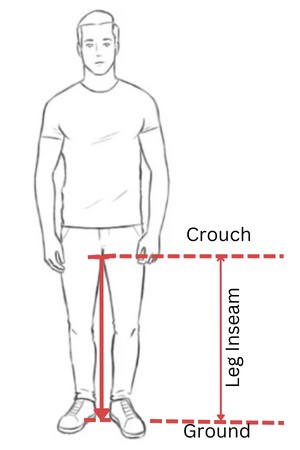
Knowing the inseam length is as important as knowing your height. It just cannot be taken in approximation; you have to be specific about it, or you will not find your comfortable fit.
The leg dictates motion from the bike’s saddle to its pedal. It’s effortless to measure the inseam on your own.
Steps to Calculate Inseam Length
- Stand with your feet slightly apart from one another and hold any article or book with a flat surface and possible edges.
- Now move up the crotch till you start to feel a little pressure in your crotch.
- Once you do, stop there and measure the distance from the group until that point.
- These days, many companies ensure to include inseam measurements within their bike charts even to smoothen out calculations and fit.
How to Measure a Bike Frame for Different Bike Types
There are many different types of bikes available on the market, and each one has its own specific rules for frame size measurement. Some of the most basic ones are as follows:
Kid Bikes Frame Size
When it comes to choosing the right bike for your child, wheel size is often the most important measurement. Bikes with 16″, 20″, 22″, and 24″ wheels are all options that should be considered. If any of these frames appear to be too small, your child may be able to fit a small adult 26″ wheel-size bicycle.
This bike size chart for kids will help you select the right-sized bike for your little one based on their age and height.
| Age (years) | Height (inches) | Height (cm) | Leg Inseam(inch) | Leg Inseam(cm) | Wheel Diameter (inch) | |
| 2 | 2’9″ – 3’1″ | 85 – 90 | 12″ – 14″ | 30 – 35 | 10 | |
| 3 – 4 | 3’1″ – 3’3″ | 90 – 100 | 14″-17″ | 35 – 42 | 12 | |
| 4 – 5 | 3’3″ – 3’7″ | 100 -110 | 16″-20″ | 40 – 50 | 14 | |
| 5 – 6 | 3’7″ – 3’8″ | 110–115 | 18″-22″ | 45 – 50 | 16 | |
| 6 – 8 | 3’8″ – 4’0″ | 115- 120 | 20″-24″ | 50 -60 | 18 | |
| 7 – 9 | 4’0″ – 4’5″ | 120–135 | 22″-25″ | 55 – 63 | 20 | |
| 9 – 11 | 4’5″ – 4’9″ | 135–145 | 24″-28″ | 60 – 72 | 24 | |
| 11 + | 5’0″ + | 145 + | 28″ + | 72 + | 26 |
If your child falls outside of the recommended range, you may want to consider going up or down one size accordingly. Ultimately, comfort and safety should be your top priorities when selecting a kid’s bike frame size.
Mountain Bikes Frame Size
Mountain bikes are designed for riding on rough and uneven terrain, so they need to be tough and durable. That’s why mountain bike frames are usually smaller in size than road bike frames. A smaller frame gives the rider more control over the bike against the forces of the terrain.
The height of the mountain bike frame is measured in inches, and the size chart below shows the approximate frame size for each height range. Keep in mind that women’s mountain bikes usually have a smaller frame than men’s bikes.
Here is the bike size chart for men
| Height (ft/inch) | Height (cm) | Suggested Frame Size (inch) | Frame Size (Marker) |
| 4′ 10″ – 5′ 2″ | 148 – 158 | 13 – 14 | XS |
| 5′ 2″ – 5 ‘6″ | 158 – 168 | 15 – 16 | S |
| 5′ ‘6″ – 5’ 10″ | 168 – 178 | 17 – 18 | M |
| 5′ 10″ – 6′ 1″ | 178 – 185 | 19 -20 | L |
| 6′ 1″ – 6′ 4″ | 185 – 193 | 21 – 22 | XL |
| 6 ‘4″ – 6’ 6″ | 193 – 198 | 23 – 24 | XXL |
Here is the MTB size chart for Women
| Height (inch) | Height (cm) | Suggested Frame Size (inch) | Frame Size (Marker) |
| 4′ 10″ – 5′ 2″ | 148 – 158 | 13 – 14 | XS |
| 5′ 2″ – 5 ‘6″ | 158 – 168 | 15 – 16 | S |
| 5′ 6″ – 5′ 10″ | 168 – 178 | 17 – 18 | M |
| 5′ 10″ – 6′ 1″ | 178 – 185 | 19 + | L |
If you’re still not sure what size mountain bike you need, you can always ask an experienced salesperson at your local bike shop. They’ll be able to help you find the perfect bike for your height and riding style.
Road Bikes Frame Size
Road bikes’ frame sizes are popularly measured in centimeters. If you are a U.S. citizen, multiplying the length you have in inches by 2.54 will bring you closer to the imperial sizes. Streamlined road bikes are very useful daily and extremely popular among commuters.
To find the suitable seat tube length multiply the calculated inseam length by 0.7. If the seat tube size in a bicycle exceeds the inseam length, you will face significant difficulty pedaling. A multiplication of 0.7 will decrease the measurement, making it optimum for road bikes. Long rides will become more accessible with this.
Here’s a chart with road bike sizes for women to give you better clarity of sizing:
| Height (ft/inches) | Height (cm) | Suggested Frame size (cm) | Frame Size (Marker) |
| 4′ 10″ – 5′ 1″ | 147 – 155 | 44 – 45 – 46 | XXS |
| 5′ 1″ – 5′ 3″ | 155 – 160 | 47 – 48 – 49 | XS |
| 5′ 3″ – 5′ 5″ | 160 – 165 | 50 – 51 – 52 | S |
| 5′ 5″ – 5′ 8″ | 165 – 172 | 53 – 54 – 55 | M |
| 5′ 8″ – 5′ 10″ | 172 – 180 | 56 – 57 | L |
Road Bike size chart for Men
| Height (ft/inches) | Height (cm) | Suggested Frame size (cm) | Frame Size (Marker) |
| 4′ 10″ – 5′ 0” | 148 – 152 | 47 – 48 | XXS |
| 5′ 0 “- 5′ 3” | 152 – 160 | 49 – 50 | XS |
| 5′ 3″ – 5′ 6″ | 160 – 168 | 51 – 52 – 53 | S |
| 5 6″ – 5′ 9″ | 168 – 175 | 54 – 55 | M |
| 5′ 9″ – 6′ 0″ | 175 – 183 | 56 – 57 – 58 | L |
| 6′ 0″ – 6′ 3″ | 183 – 191 | 58 – 59 – 60 | XL |
| 6′ 3″ – 6′ 6″ | 191 – 198 | 61 – 62 – 63 | XXL |
Touring Bikes Frame Size
Touring bikes are quite similar to road and commuter bikes. They have a longer wheelbase to make carrying panniers easy on a rear rack. Talking about positioning on these bikes so they come with handlebars in multiple positions.
This allows riders enough freedom of changing hand positions which ultimately helps them sit more upright to relieve their back pressure.
Now it’s very important that you make the right adjustments on your bike before getting into the habit of riding. Because the wrong fit sometimes feels comfortable but in the long run does great harm to soft tissues, bones, and muscles.
One way to know your right fit is a touring bike’s frame size chart. Hopefully, this chart will help you pick the right bike.
It’s always best to try out a few different bikes before making your final decision. But hopefully, these charts will give you a starting point for finding the perfect road bike for your needs.
| Body Size (cm) | Bike Frame Size (cm) |
| 155 – 160 | 42 – 47 |
| 160 – 170 | 47 – 52 |
| 170 – 175 | 52 – 54 |
| 175 – 180 | 54 – 56 |
| 180 – 185 | 56 – 58 |
| 185 – 190 | 58 – 60 |
| 190 – 195 | 60 – 63 |
| Above 195 | Above 63 |
Cyclocross Bikes Frame Size
Cyclocross bikes use exactly the same conventions as are used by road bikes. A prominent feature of this bike is its aggressive positioning.
They come in a diverse range of options so try out them all to understand the feel of each type. This may sound stupid to experiment but believe us it works quite well. And will ultimately leave you with the right choice.
| Body Size (cm) | Bike Frame Size (cm) |
| 155 – 160 | 47 – 49 |
| 160 – 165 | 49 – 51 |
| 165 – 170 | 51 – 53 |
| 170 – 175 | 53 – 55 |
| 175 – 180 | 55 – 57 |
| 180 – 185 | 57 – 60 |
| 185 – 190 | 60 – 62 |
| 190 – 195 | 62 – 64 |
| Above 195 | Above 64 |
Cruisers, Hybrids, or Cross Bikes Frame Size
In reality, cruisers, hybrids, and cross bikes are all the same type of bike. They are quite affordable and most importantly come in various sizes to fit almost all. Even you can find their large and extra-large sizes without any sort of difficulty.
However, the cruiser makes an exception because it comes in only one size. But that can’t be a problem for any rider because they are not engineered for performance. And are only meant to be ridden for hardly a few hours.
With this now let’s understand their frame sizing. So, that you get a clear vision for your purchase.
| Height (ft/inches) | Height (cm) | Leg Inseam (inch) | Leg Inseam (cm) | Frame Size (inch) | Frame Size (Marker) | |
| 4’10” – 5’1” | 147 -155 | 24” – 29” | 61 – 73 | 14″ | XS | |
| 5’1″ – 5’5″ | 155 -165 | 25″ – 30″ | 63 – 76 | 15″ | S | |
| 5’5″ – 5’9″ | 165 -175 | 26″ – 31″ | 66 – 78 | 16″ | M | |
| 5’9″ – 6’0″ | 175 -183 | 27″ – 32″ | 68 – 81 | 17″ | L | |
| 6’0″ – 6’3″ | 183 -191 | 28″ – 33″ | 71 – 83 | 18″ | XL | |
| 6’1″ – 6’6″ | 191 -198 | 29″ – 34″ | 73 – 86 | 19″ | XXL |
What to do if you are closer to standard size charts but still need to arrive?
God did not make bike size charts, so they could not include your perfect bike fit. Just remember bike size charts are suggestive parameters.
If you are taller, it’s wise to go for a larger frame to counterbalance your extended arms and legs, whereas, if you are short and cute, moving towards a more petite frame will be more convenient.
Conclusion — Measuring Frame of A Bike
We are sure our guide will help you to make the right choice, and you won’t have to worry about the bicycle frame anymore. You should only take into consideration your shoes and where you’re going.
Still, if you have any suggestions or doubts or something that I have missed, feel free to drop a comment below. I will be more than happy to assist you with your query. Please follow our Facebook Page for more guides like this.
Come on set off on your next bike ride, and enjoy every minute!
How to Measure Bike Frame — FAQs
What does 26″ or 26 inches mean for Bikes?
All it means is that the wheels are 26 inches in diameter. It doesn’t talk about the frame size because if it did, it would be too large for a bike.
What Bike Frame Size Do You Need?
The frame size will be influenced by the kind of bike you want to opt for— whether it’s a mountain bike, road bike, or any other. Eventually, everything boils down to your decision based on your unique personal preference.
Now you may ask why?
Because the kind of bike you choose to ride is again based on your requirements and wants. Some people look for hybrid bikes, while others want to make their way to unknown terrains.
You may also be buying a bike for your young one. Make sure to know what you want before you look at the options.
How do I figure out what size bike I need?
When it comes to finding the right-sized bike first, you need to understand the measurement process of bike frames and how to read bike size charts. This will help you estimate the precise size that you need.
Secondly, you need to consider your own riding style and preferences. This will help you narrow down the range of sizes that would be suitable for you.
Finally, you need to test-ride a few bikes before making your final decision. This will ensure that you get the best possible fit.
Related:
